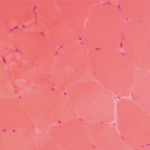Next generation sequencing via a rhabdomyolysis gene panel may be a more appropriate investigation than traditional muscle biopsy & related tests. The idea is that such tests may provide improved diagnostic sensitivity & quicker time to diagnosis.
Importance of Prompt Diagnosis
Although those with more severe infantile presentations will attract immediate investigation, people with milder phenotypes may experience symptoms for years before coming to medical attention. For example, many patients with McArdle’s disease are misdiagnosed with “growing pains” as children before they finally receive a correct diagnosis, often years later.6
Under ideal circumstances, metabolic myopathies should be diagnosed promptly. In a few cases, targeted therapies are available. In all cases, dietary and exercise interventions can help prevent morbidity and mortality from possible rhabdomyolysis, which can occur in these patients under conditions of metabolic stress. Rheumatologists can play an important role in diagnosing such patients and directing them to appropriate care.
Josef Finsterer, MD, PhD, is a professor of neurology at the University of Vienna, Austria. He points out that correct diagnosis can have important implications for the management of surgery and general anesthesia in such patients. Having the correct diagnosis also has implications for pregnancy, both for family planning purposes (and possible prevention of disease transmission) as well as for optimal management of pregnancy and delivery. Such conditions also need prompt diagnosis, since in some cases they are accompanied by serious medical problems that require management (especially in the case of mitochondrial disease). Accurate and early diagnosis can also prevent inappropriate and unnecessary interventions.1,5
Diagnosing Metabolic Myopathies
Dr. Tarnopolsky speculates that a rheumatologist may be most likely to encounter a patient with a metabolic myopathy as a referral from a family practice doctor for muscle weakness or for a high creatinine kinase (CK) level occurring with or without actual rhabdomyolysis.
“The challenge is that such a differential is extremely large,” he notes. This differential includes fixed structural genetic myopathies, such as limb girdle dystrophy, as well as inflammatory myopathies, such as dermatomyositis. “It’s sometimes challenging—separating those with metabolic disease from those with fixed structural disease or inflammatory disease and getting a final diagnosis—because there can be many mimics.”
Depending on the context, rheumatologists may need to consider other possible etiologies, such as endocrine or electrolyte-related myopathy, infectious myositis, malignant hyperthermia, other rare, genetic causes of myositis, medication-
related myositis, or non-myopathic syndromes, such as fibromyalgia.7
Medical history
As with many conditions in rheumatology, a detailed and careful medical history is critical for correct diagnosis of metabolic myopathies. Dr. Finsterer suggests dividing the history into two parts: undirected free speech of the patient followed by a structured questionnaire geared to recognizing possible key manifestations of myopathies.
Asking about exertional pain is key, because metabolic myopathic patients have usually suffered from exercise intolerance for years, with such symptoms as premature fatigue, episodic aches and cramps during activity. “When you ask them the questions, such as, ‘When you play soccer or hockey, were you having cramps? Did you ever get dark urine after intense exercise?’, often there is a positive history,” explains Dr. Tarnopolsky. “That’s different from a patient with inflammatory myopathy who usually has a subacute onset of progressive weakness, with or without a fixed myalgia.”
Unfortunately, getting such a history sometimes proves surprisingly difficult. Some patients may be so accustomed and adapted to their symptoms that they may deny exercise intolerance even if asked repeatedly. Yet after a correct diagnosis is made, they may retrospectively acknowledge their symptoms. It is sometimes helpful to ask family members about such complaints.
In people with fat oxidation defects, symptoms don’t usually occur unless people haven’t eaten in a long period of time or they engage in a longer duration activity. Other potential triggers can include extremes of temperature, general anesthesia and certain drugs (e.g., ibuprofen and diazepam).5
Dr. Tarnopolsky notes that some cases of FAOD or mitochondrial disease are picked up when a child gets sick and experiences sore muscles and/or rhabdomyolysis. He adds, “We do have a few, especially females, who may have mild symptoms. The patient might have worked out on the weekend, and then they go to the family doctor, have a high CK and might be sent to a rheumatologist.”
A diagnostic challenge: Even healthy people can sometimes overexert themselves, producing a high CK and even rhabdomyolysis. But the metabolic myopathy patient will usually have a recurrent history, experiencing symptoms from types of activities that would not give others such problems.
Some patients with mitochondrial disease present with a classic-appearing metabolic myopathy with episodic myopathic symptoms only. These overlap with many of the triggers of symptoms for FAOD disorders: prolonged exercise, fasting, fever, surgery or other such metabolic stressors. However, most patients with mitochondrial disease also present with non-myopathic symptoms that yield other diagnostic clues, and some will have a fixed, non-dynamic myopathy.5
Asking specifically about the second-wind phenomenon can be a critical clue for diagnosing McArdle’s disease (a glycogenolytic defect). Because of the particular nature of the deficit, McArdle’s patients often report a “second wind phenomenon” due to the delivery of blood-borne substrates to the muscle. A typical history is that the initial cramping sensation with vigorous exercise may lessen after a short rest or reduction in intensity, followed by a resumption of activity that feels much easier. Patients with GSDs with glycolytic-type defects do not experience a “second wind.”4
History is also key in distinguishing a possible metabolic myopathy from an inflammatory myopathy or a muscular dystrophy. “Generally, someone with an inflammatory myopathy is going to have a subacute presentation,” Dr. Tarnopolsky notes. “Thus, it’s going to be weeks to months when they experience the weakness, and it’s usually insidious in its onset.” He notes that muscular dystrophies can look very similar, though they usually have a much longer time of gradual onset.
A comprehensive review of systems is also warranted, with emphasis on potential symptoms that might point to particular metabolic myopathies or other myopathy types (see Table 1).

